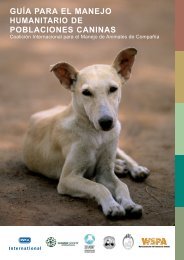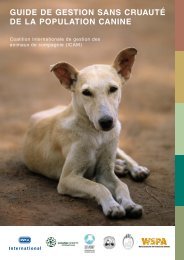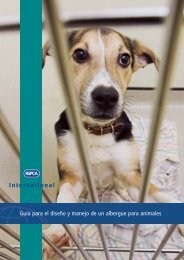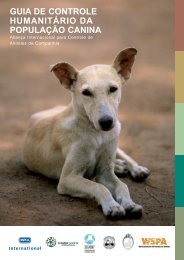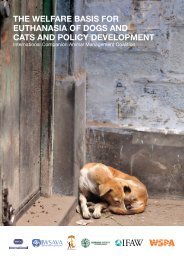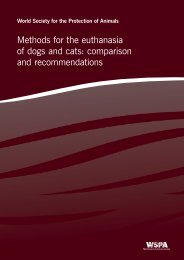HUMANE DOG POPULATION MANAGEMENT GUIDANCE - ICAM ...
HUMANE DOG POPULATION MANAGEMENT GUIDANCE - ICAM ...
HUMANE DOG POPULATION MANAGEMENT GUIDANCE - ICAM ...
You also want an ePaper? Increase the reach of your titles
YUMPU automatically turns print PDFs into web optimized ePapers that Google loves.
The following are common areas of dog management<br />
programmes that may require minimum standards to be<br />
applied:<br />
a. surgery, including aseptic techniques, anaesthetics and<br />
drug regimes (e.g. analgesia)<br />
b. handling and transporting of dogs<br />
c. housing and husbandry of dogs<br />
d. rehoming procedures<br />
e. euthanasia – when euthanasia should be used and how it<br />
should be carried out<br />
f. record keeping and regular analysis of data – although<br />
not directly affecting animal welfare, good recording<br />
keeping that covers the incidence of disease or injury can<br />
help identify parts of the programme that may be<br />
compromising welfare. For example, an usually high<br />
incidence of post-operative complications at certain times<br />
may indicate the need for refresher training for certain<br />
veterinary staff or a change in post-operative care.<br />
Surgery using aseptic techniques, Thailand.<br />
RAY BUTCHER/PHUKET ANIMAL WELFARE SOCIETY<br />
CASE STUDY 7<br />
An example of steps for designing interventions<br />
A. Understand the situation<br />
A questionnaire was conducted in Municipality X, which was reported to have the highest number of complaints about roaming<br />
dogs. The questionnaire answers showed that 50 per cent of the people who owned female dogs reported they have too many<br />
puppies to deal with and that finding homes is a problem. They also reported 45 per cent of the puppies as ‘lost’. The level of<br />
sterilisation in the female dog population was found to be just three per cent. Owners reported a lack of confidence in local vets’<br />
ability and a worry that their dogs’ personalities would change as a result of sterilisation.<br />
B. Prioritise the relevant factors<br />
The priority factor here is dog reproduction – there is a surplus of unwanted puppies in the owned population, a need to increase<br />
sterilisation levels in owned dogs, and a need to address the vets’ ability and the misunderstanding of the impact of sterilisation on<br />
dog behaviour.<br />
C. Components of a comprehensive programme<br />
The components are: surgical sterilisation through local veterinary infrastructure; the education of both vets in surgery and local<br />
dog owners on the importance of sterilisation.<br />
D. Design the intervention<br />
From this, an aim was written: to reduce the number of unwanted and roaming dogs susceptible to disease and injury on the<br />
streets of Municipality X. In order to achieve this aim, several objectives were written, one of which was to increase sterilisation of<br />
owned female dogs from three per cent to 50 per cent in two years. Fifty per cent was chosen as a target because 50 per cent of<br />
the owners reported a problem with excess puppies. Two years was chosen both because of practical resources (clinic time and<br />
funding) and to allow time for the impact of the programme to become evident.<br />
This objective will involve activities such as:<br />
training to improve surgical sterilisation skills in four local vets, which is paired with two incentives: a voucher system allowing<br />
vets to offer low-cost sterilisation services subsidised by a local NGO and a simple marketing plan for the clinic around the<br />
subject of low-cost sterilisation<br />
an education programme, using posters and the local community network focused on the local religious leader, which explains<br />
the benefits of sterilisation to dog owners with regards to health and behaviour.<br />
18



